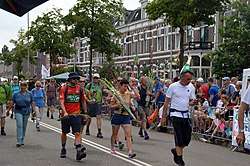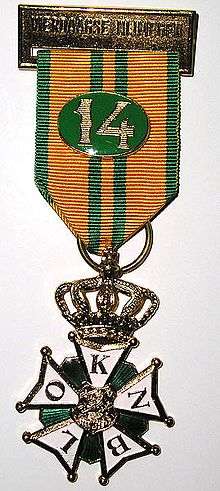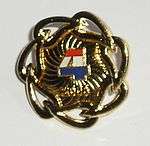International Four Days Marches Nijmegen
The International Four Day Marches Nijmegen (Dutch: Internationale Vierdaagse Afstandsmarsen Nijmegen) is the largest multiple day marching event in the world. It is organised every year in Nijmegen, Netherlands in mid-July as a means of promoting sport and exercise. Participants walk 30, 40 or 50 kilometres daily depending on their age and gender and, on completion, receive a royally approved medal (Vierdaagsekruis). The participants are mostly civilians, but there are also a few thousand military participants.
| International Four Days Marches Nijmegen Internationale Vierdaagse Afstandsmarsen Nijmegen | |
|---|---|
 Flag of the Four Days Marches | |
 Arrival of participants in 2019 | |
| Status | Active |
| Genre | Marching event |
| Frequency | Annually |
| Location(s) | Nijmegen and surroundings |
| Country | Netherlands |
Standard distances:
- 30 km × 4 days
- 40 km × 4 days
- 50 km × 4 days
Military category:
- 40 km × 4 days – Wearing uniform + at least 10 kg (+ water, etc.) marching weight for males aged 18–49, for females the weight is optional.
Summary
The "Vierdaagse" (Dutch for "four days event") is an annual walk that has taken place since 1909. Based at Nijmegen since 1924, it now takes place in the third week of July. In 2016 it celebrated the 100th edition (reflecting that the marches were curtailed during the two world wars). Depending on age group and gender, walkers have to walk 30, 40 or 50 kilometres each day for four days. Originally a military event with a few civilians, it now is a mainly civilian event. Numbers have risen in recent years, with over 40,000 taking part, including about 5,000 military,[1] and is now the world's largest walking event. Due to possible congestion on the route, since 2004 the organisers have limited the number of participants. Many take part every year, including several who have taken part in over 60 annual marches. The current record is held by Bert van der Lans, who completed his seventy-first march 2018, when aged 86.[2]
Each day of the marches is named after the biggest town it goes through. Tuesday is the day of Elst, Wednesday the day of Wijchen, Thursday the day of Groesbeek and Friday the day of Cuijk. The routes always remain the same unless there is a specific need to change. This happened in 2007 (route changed in 2006 but cancelled) when the walkers went along the Waalkade, beside the River Waal, on Wednesday for the first time due to congestion on the original route. The 2006 march was the first to be cancelled in 90 years (apart from 1940 due to World War II). The extreme heat meant that during the first day's march there were thousands of drop-outs and two deaths.
Following the 2006 cancellation, it was decided that in future the organising committee would adjust the start time/distance/finish time to manage the event, instead of outright cancellation. The 2016 centenary event responded to unusually hot conditions by adjusting the starting times, and/or increasing the valid finishing time to reflect the difficulty of course.
On the Friday, as participants near the finish, the public presents the walkers with gladioli, a symbol of victory since Roman times, when gladiators were likewise showered with these flowers. The entry into the city and towards the finish, along the St. Annastraat, is for that reason called Via Gladiola during the Nijmegen Marches. As far as a week ahead people will reserve spaces alongside the Via Gladiola by placing chairs and even couches. The finish is also shown on Dutch television.
Due to the coronavirus pandemic, the 2020 Vierdaagse event was cancelled.[3]
Awards

The marching event has three different types of awards:
- Cross for the Four Day Marches (Dutch: Vierdaagsekruis): awarded to participants who successfully completed the Four Days Marches according to regulations. The medal is an official Dutch decoration that can be worn on a Dutch military uniform. It is fully named "Cross for demonstrated marching skill", as defined by Royal Decree on 6 October 1909. Each year a walker receives a specific medal in bronze, silver or gold, with or without a crown, as well as ribbon numbers of varying design, to denote the number of times the event has been completed.
- Group Medal of the Four Day Marches
- Orderly Medal of the Four Day Marches (not an official award since 2017)
History
Early years
In April 1908 the Dutch League for Physical Education, (Nederlandsche Bond Voor Lichamelijke Opvoeding, or NBVLO) was established to promote participation in physical activities across the Netherlands, including organising sports events. In September 1909 the NBVLO organised the first Vierdaagse. Planned primarily as a military training event, fifteen separate four-day routes were prepared across the country, each route totalling 140-150 km. Four of the routes were however cancelled at short notice, three due to an outbreak of cholera in Rotterdam and one due to poor road conditions. In total, 306 soldiers and ten civilians took part. Military participants who completed all four days received the newly instituted Vierdaagse Cross.[4]
From 1910 the Vierdaagse became an annual event, based in a different town each year, although mobilisation during World War I meant that no marches took place in 1914 or 1915. In 1919 the first woman completed the route. In 1924 the event was held in Nijmegen, and from 1925 this became the permanent centre for the event.[5]
With Amsterdam hosting the Olympic Games, in 1928 the Four Days Marches became international, with teams taking part from Germany, Great Britain and Norway. Non-Dutch participation continued, with the first Swiss group taking part in 1933.[6] From the 1920s the numbers of walkers increased significantly. In 1920 under 500 had taken part,[7] compared with 1,155 in 1928. In 1931 numbers exceeded 2,000 for the first time, with over 3,000 in 1935 and over 4,000 in 1937. The increase was mainly due to greater civilian participation, civilians outnumbering servicemen in all marches from 1932.[8]
After a successful trial event in 1935, four–day marches held annually at various locations across the Dutch East Indies between 1936 and 1939. Organised by the Dutch Indies Athletic Union under the auspices of the NBVLO, these events adhered to the same regulations as the Nijmegen event, with successful participants receiving the same awards, including the Vierdaagse Cross, and the Group Medal.[9]
The 1940 Vierdaagse was cancelled after the German invasion, with a local Nijmegen walking club organising an emergency (nood in Dutch) Four–Days March in August 1940. About 1,000 walkers took part each day, rising to over 2,000 on the final day, with many participants attending from across the country. In 1941 the NBVLO planned a vierdaagse based in Nijmegen. Preparation for the July event included publication of the official rules, which forbade any political display, including uniforms and flags. In spite of this, the march was banned by the German authorities. A number of small scale four–days walking events did however take place in 1941, including a number of less formal evening walks. With unauthorised gatherings increasingly restricted, no further events were organised before the end of the war.[10]
Since 1945
Despite Nijmegen suffering considerable war damage, the Vierdaagse recommenced in Nijmegen in 1946 with over 4,000 participants.[11]

The popularity of the Four Days Marches continued to increase, breaking the 10,000 barrier in 1954. The participation in 1967 of Prince Claus, husband of Queen Beatrix, helped to boost the event's popularity yet further, with over 20,000 taking part in 1982 and 30,000 by 1988. The number of participants now regularly exceeds 40,000. Due to this growth, since 2004 there has been an upper limit on the number taking part,[12] with a record 48,986 registering for the 100th March in 2016.[13] This increase has been boosted by a rising number attending from across the world. In 2019 6,347 non-Dutch walkers from 73 countries took part.[14]
In 1972 hot weather led to a shortening of the distances by 10 km each day.[15] In 2006 the event was again affected by extreme heat, when it was cancelled after the first day after two participants died and many others required medical attention. Given the hot weather forecast for the following days, the organisers decided to cancel the final three days of the walk, with a special badge awarded to participants instead of the cross.[12]
On 17 July 2014, flight MH17 was shot down with 192 people from the Netherlands on board. In memory of the crash, no music was played on the last day of the marches and the festivities toned down. The 100th Four Days Marches took place in July 2016, celebrated by numerous side events, including an optional daily 55 km route, the maximum official distance until 1967.
On 21 April 2020 the Vierdaagse organisers announced that the 2020 event would not take place due to the coronavirus pandemic.[3]
Military participation
Originally primarily a military training event for the Dutch infantry, since 1928 the Vierdaagse has attracted armed forces personnel from other countries, when Germany and Norway sent army teams. Forces teams increased greatly after 1945. The U.S. Army first took part in 1947, the United Kingdom in 1950 and Canada in 1952, with service contingents now also regularly travelling from Germany, Scandinavia, Switzerland and others. In recent years military participants, including Dutch personnel, have numbered approximately five thousand, most marching in teams of between eleven and thirty members. They are required to carry at least 10 kilogrammes of dead weight (if they are over 18 years of age), although this requirement can be waved when temperatures get too high, as happened in 2006 and the last day of the 2014 march. Military teams have their own route, (40 km), as they do not start in Nijmegen but in the military camp Heumensoord, just south of Nijmegen, which is built for the event every year.
Vierdaagsefeesten
During the week of the Vierdaagse the accompanying festivities (known as the Vierdaagsefeesten) always draw a large crowd. It is known as one of the biggest festivities in the Netherlands, drawing a crowd of 1 million visitors.[12] It starts on the Saturday before the marches, and ends on the Friday. There is free music during the week, and special events on each day, such as a firework display on Monday night. Amongst the festivities is the annual rock festival de Affaire that takes place every day during the Vierdaagsefeesten.
Recent marches
| Recent marches | |||||
|---|---|---|---|---|---|
| Edition | Date | Participants | Finished [16] | Dropped out | Dropped out percentage of starters |
| 95th | 19–22 July 2011 | 42,812 | 38,422 | 4,390 | 10.3% |
| 96th | 17–20 July 2012 | 41,472 | 38,144 | 3,328 | 8.0% |
| 97th | 16–19 July 2013 | 42,493 | 39,396 | 3,097 | 7.3% |
| 98th | 15–18 July 2014 | 43,013 | 39,910 | 3,103 | 7.2% |
| 99th | 21–24 July 2015 | 42,684 | 40,092 | 2,592 | 6.1% |
| 100th | 19–22 July 2016 | 47,166 | 42,557 | 4,609 | 9.8% |
| 101st | 18–21 July 2017 | 42,036 | 38,409 | 3,627 | 8.6% |
| 102nd | 17–20 July 2018 | 44,480 | 41,006 | 3,474 | 7.8% |
| 103rd | 16-19 July 2019 | 44,702 | 41,235 | 3,467 | 7.8% |
| 104th | 21–24 July 2020 | Cancelled | — | — | — |
References
- De 4Daagse website 2020, p. Statistics 2013-2019 pdf.
- "Van der Lans scherpt record verder aan". De Gelderlander. 20 July 2018.
- Stichting de Vierdaagse: Cancellation announcement
- KNBLO 1991, pp. 11-13.
- KNBLO 1991, pp. 14-33.
- KNBLO 1991, pp. 37-38.
- Cottaar 1966, p. 126.
- Cottaar 1966, p. 128.
- KNBLO 1991, pp. 59-63.
- KNBLO 1991, pp. 76-77.
- KNBLO 1991, pp. 78-80.
- De 4Daagse website 2020, p. History of the Four Days Marches pdf.
- De 4Daagse website 2020, p. Statistics 2016 pdf.
- De 4Daagse website 2020, p. Statistics 2019 pdf.
- KNBLO 1991, p. 129.
- De 4Daagse website 2020, p. Statistics 2013-19 pdf.
Sources
- Cottaar, Jan (1966). Op Gouden Voet (in Dutch). Nijmegen.CS1 maint: ref=harv (link)
- De 4Daagse website, Stichting (2020). Archive Downloads. Stichting De 4Daagse.CS1 maint: ref=harv (link) Accessed 7 July 2020
- KNBLO (1991). De Wereld Wandelt (in Dutch). Nijmegen.CS1 maint: ref=harv (link)
External links
| Wikimedia Commons has media related to International Four Days Marches Nijmegen. |